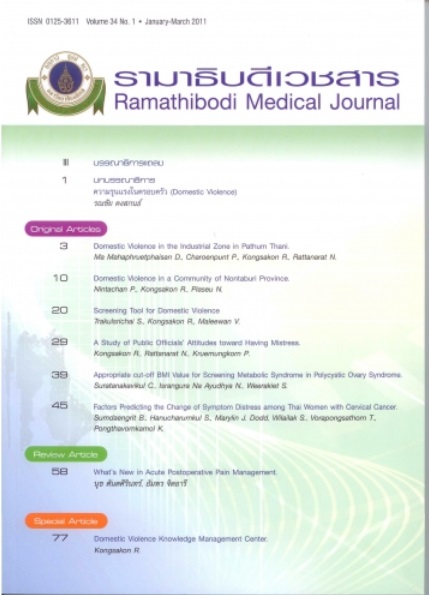Screening Tool for Domestic Violence
Keywords:
Domestic violence, Screening toolAbstract
Domestic violence (DV), now a national health concern, has pervasive effects at both individual and social levels. Domestic violence is one of the most the most prevalent causes of injury in women. The impact of DV on society is very extreme. In the respect of medical expenses, after controlling other factors, medical cost of a woman with physical or sexual violence is 2.5 times higher than that without the violence. So awareness of this problem including early detection, giving the proper management and concern for the prevention can help the victims from more severity, frequency or serious adverse to health and potentially life threatening consequence they will face in the future.
Screening for domestic violence in the health care setting has been recommended routinely in the practice by some professional organization for the early detection and management. Health care professionals can play a major role to assist abused victim. Identification of the cases is the first aspect of care. So many screening strategies and tools have been developed including the complete history, physical examination and the screening questionnaire for this purpose. Professional staff should become familiar and proficient with these screening tools.
References
Chinlumprasert N. Academic seminar: Management of Violence Against Women and Children. Nonthaburi: Public Health System Research Institute; 2002.
Office of Women's Affairs and Family Development, Ministry of Social Development and Human Security. Domestic Violence Victim Protection Act B.E. 2550. Available from: https://www.pga-ju.ago.go.th/images/document/1.pdf.
Prueksaritanond S, Uttawichai K, Wadhanakul K. Practice Guidelines: Operation and Assistance for Domestic Violence in Family Practice. Bangkok; 2008.
Office of Women's Affairs and Family Development. Results of a Public Opinion Survey: Domestic Violence in Family. Available from: https://www.women-family.go.th/family/doc/4.2.pdf.
Centers for Disease Control and Prevention (CDC). Lifetime and annual incidence of intimate partner violence and resulting injuries--Georgia, 1995. MMWR Morb Mortal Wkly Rep. 1998;47(40):849-53.
Hamberger LK, Saunders DG, Hovey M. Prevalence of domestic violence in community practice and rate of physician inquiry. Fam Med. 1992;24(4):283-7.
Office of Public Health System Development. One Stop Crisis Centers for Women and Children Victims of Violence at the Provincial Level. Nonthaburi: Office of Public Health System Development, Department of Health Service Support, Ministry of Public Health; 2007. Available from: https://www.women-family.go.th/family/doc/cv.pdf.
Flitcraft A. Physicians and domestic violence: challenges for prevention. Health Aff (Millwood). 1993;12(4):154-61. doi:10.1377/hlthaff.12.4.154.
Fisher V. Working with Battered Women: A Handbook for Health Care Professionals. Hotpeachpages; 2001. Available from: https://www.hotpeachpages.net/canada/air/medbook.
Zawitz MW. Highlights from 20 Years of Surveying Crime Victims: the National Crime Victimization Survey, 1973-1992. Washington, DC: US Department of Justice, Office of Justice Programs, Bureau of Justice Statistics; 1993.
Berrios DC, Grady D. Domestic violence. Risk factors and outcomes. West J Med. 1991;155(2):133-5.
McFarlane J, Parker B, Soeken K, Silva C, Reel S. Safety behaviors of abused women after an intervention during pregnancy. J Obstet Gynecol Neonatal Nurs. 1998;27(1):64-9. doi:10.1111/j.1552-6909.1998.tb02592.x.
Sullivan CM, Bybee DI. Reducing violence using community-based advocacy for women with abusive partners. J Consult Clin Psychol. 1999;67(1):43-53. doi:10.1037//0022-006x.67.1.43.
Basile KC, Hertz MF, Back SE. Intimate Partner Violence and Sexual Violence Victimization Assessment Instruments for Use in Healthcare Settings: Version 1. Atlanta (GA): Centers for Disease Control and Prevention, National Center for Injury Prevention and Control; 2007. Available from: https://stacks.cdc.gov/view/cdc/44660/cdc_44660_DS1.pdf.
Kongsakon R, Bhatanaprabhabhan D. Family Violence Management. In: Kongsakon R, Pocham N, eds. Domestic Violence. Bangkok: Sahaprchapanich; 2008.













